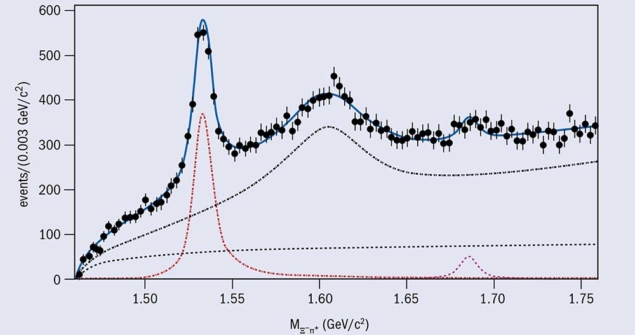
High-luminosity collisions of electrons and positrons at the KEKB accelerator in Japan have established the existence of a new baryon with strangeness S = –2, shedding light on the structure of doubly-strange hyperon resonances. In a preprint submitted to Physical Review Letters, researchers at KEKB’s Belle experiment report the first observation of the Ξ(1620)0 based on a 980 fb−1 data sample. The collaboration also found evidence for the slightly heavier Ξ(1690)0.
The constituent-quark model has been very successful in describing the Ξ or “cascade” baryon. Discovered in cosmic-ray experiments half a century ago, and corresponding to the ground state of the flavour-SU(3) octet, it contains one u or d quark plus two more massive quarks (the Ξ0 is made of one u and two s quarks). However, some observed excited states do not agree well with the Standard Model prediction. The study of such unusual states therefore probes the limitation of the quark model and could reveal unexpected aspects of quantum chromodynamics (QCD).
Belle researchers uncovered the resonance from its decay to Ξ−π+ via Ξ+c → Ξ−π+π+, measuring its mass and width to be 1610.4 ± 6.0 (stat) (syst) MeV/c2 and 59.9 ± 4.8 (stat) (syst) MeV, respectively. The values are consistent with those from previous sightings at other experiments, and the width of the Ξ(1620)0 turns out to be somewhat larger than that of the other exited Ξ states.
Experimental evidence for the Ξ(1620) → Ξπ decay was first reported in K−p interactions in the 1970s, but there has been a lingering theoretical controversy about the interpretation of both the Ξ(1620) and Ξ(1690) states because the quark model predicts the first excited states of Ξ to have a mass of around 1800 MeV/c2. The latest results from Belle hint that these states represent a new class of exotic hadrons, writes the team: “The situation is similar to the two poles of the Λ(1405) and suggests the possibility of two poles in the S = −2 sector. Studying these states may explain the riddle about the Λ(1405); consequently, the interplay between the S = −1 and S = −2 states can help resolve this long-standing problem of hadron physics.”
The Belle detector has recently been superseded by Belle II at the upgraded SuperKEKB facility (CERN Courier September 2016 p32). Experiments at the LHC are also turning up new Ξ states. In 2012, CMS detected a Ξ*0b, while in 2014 the LHCb experiment discovered the Ξ′−b and Ξ*−b, and, in 2017, the doubly charmed Ξ++cc. Taken together, hadron-spectroscopy studies such as these are helping to piece together the complex process by which fundamental QCD objects combine into hadronic matter (CERN Courier April 2017 p31).
Further reading
Belle Collaboration 2018 arXiv:1810.06181.







